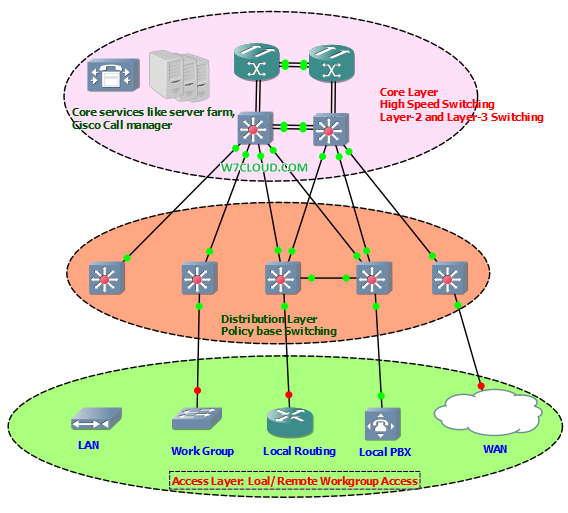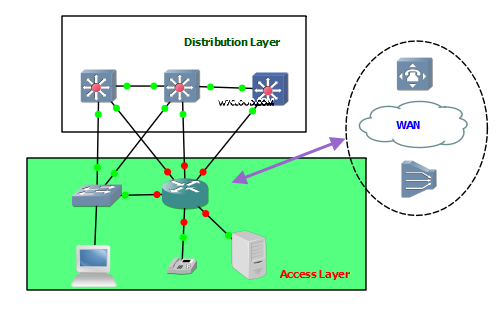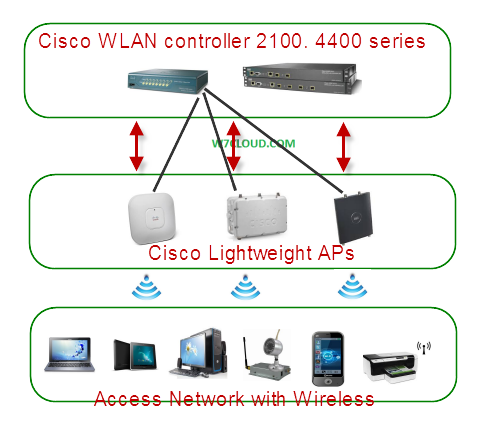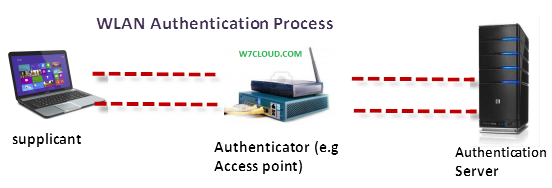
Cisco three Layer Model:
Cisco has three layer hierarchical network model that consist of following layers:
- Core Layer
- Distribution Layer
- Access Layer
This three layered model is the basic foundation for creating small and larger Networks. Using this we can design a hierarchical network with dividing the network into 3 different layers which also help us in reducing the network complexity. Today’s networks are complex and large, wide variety of technology, running multiple services and also having challenges with functionality, increasing demand of bandwidth and compatibility with other businesses and venders. So for designing large networks we need to have such hierarchical model for designing our network.
Advantages of Cisco 3-Layered model:
- Provide the flexibility in our network with three layers distribution, each layer is mapped with physical implementation and each of layers has its own features and functionality.
- 3 layer model is easier to understand and easy to grow your network.
- 3 layer model is easy to troubleshoot because of its logical distribution into layer, as each layer has its own functionality.
- Allow us the lower cost in implementation.
Core Layer:
Core layer is the backbone layer of network running with high speed switching and transfers larger amount of data, also handle the requests of distribution layer. This layer has high Speed devices like high end routers and switches with large modules with layer-2 and layer-3 functionality.
Since core layer is the backbone of any network and providing services to other layers therefore this layer is reliable and have availability, also must be Redundant and have load balancing between its different links. Cisco recommends that Core layer should have mesh topology and there should be no stuff like ACL, packet handling etc.
Some of key characteristics of core-layer are as following:
- Fast transport and large amount of data
- Redundancy
- High reliability and availability
- Low latency and good manageability
- Quality of service (QoS) classification, or other processes
- Fault tolerance
- Limited and consistent diameter
In a Network the number of router hops from edge to edge is called the diameter, it is considered good practice to design for a consistent diameter within a hierarchical network.
Core layer Devices:
- High end routers and switches
- Layer-3 switches
- Gateways and media converters
- Soft Switches for IP telephone
Distribution Layer
The distribution layer is the isolation point between the network’s access layer and core layers. Distribution layer is used for policy base services, normally having layer-2 switching devices.
Distribution layer control the access of data to core, provide the redundancy to access devices Route Redistribution, Route Filtering and router summarization are performed on Distribution layer. Distribution is normally a boundary between mediums in network. The distribution layer provides aggregation of routes providing route summarization to the core. In the campus LANs, the distribution layer provides routing between VLANs.
Some of key characteristics of distribution-layer are as following:
- Route filtering by source or destination address and filtering on input or output ports
- Hiding internal network numbers by route filtering
- Policy-based connectivity
- Static routing
- QoS mechanisms, such as priority-based queuing
- Redundancy and load balancing
- Aggregation of LAN wiring closets and WAN connections
- Security filtering
- Route summarization
- Departmental or workgroup access
- Broadcast or multicast domain definition
- Routing between virtual LANs (VLAN)
- Media translations (for example, between Ethernet and Token Ring)
- Redistribution between routing domains (for example, RIP redistribution into OSPF)
Access Layer
Access layer is the lower layer of Cisco 3-layer model running different networks services and also responsible for providing access to different network resources. This is our local and remote workgroup-access that is providing access to different services like workgroups, WAN connectivity. Normally here we are running with low end devices like 2900 series switches. Access layer includes shared LAN, switched LAN and VLAN to workstations and servers, provide access to PSTN, WAN, DSL etc. Different authentication servers like TACACS+, Radius are part of access layer. Access layer has running layer-2 switching also have layer-3 services for example router on stick for vlans, different type of protocols, QOS, packet filtering, route propagation are part of access-layer. You can implement features such as dial-on-demand routing (DDR) and static routing to control costs. Remote access can include virtual private network (VPN) technology.
Some of key characteristics of access-layer are as following:
- High availability
- Layer 2 switching
- Port security
- Broadcast suppression
- QoS classification and marking and trust boundaries
- Rate limiting/policing
- Address Resolution Protocol (ARP) inspection
- Virtual access control lists (VACL)
- Spanning tree protocol (STP)
- Trust classification
- Power over Ethernet (PoE) and auxiliary VLANs for VoIP
How to Configure Cisco Router with Configurations
Learn about another Hierarchical Network Model: Cisco PPDIOO















